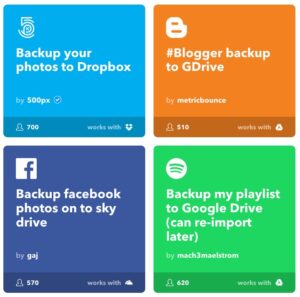This article was originally published in Computers in Libraries magazine in 2017. Some of the advice may be out of date.
Practical Technology – Your Digital Life After You
by Jessamyn West
More and more, our lives are lived online. When my father died six years ago, we were pleased to find a Google Document with the usernames and passwords to every account he ?owned?. He was an engineer and so this was not terribly surprising. Most of these accounts were things like bank account?s and cable subscriptions, but a few were email accounts and (small) social media profiles. This made a complicated time much simpler.
What if we hadn’t been able to access his information? Jan Zastrow has written a great article on digital estate planning which mentioned some of these ideas. Here are some specific tech tools you can use to help you archive and prepare your legacy on social media sites and content repositories.
Your Content, Your Wishes

Back in the wild and wooly days of blogging, most people owned their own content. Nowadays, most people’s online content lives on others’ servers. These companies might not prioritize the ability of you or your heirs to access, retrieve, or manage your content. I wrote a column here in 2014 that talked about backups; I’ll go over some of that again, since some of the information has changed. I’ve added some information about social sites’ policies about deceased users, if they have them
- Facebook has a remarkably helpful help page on what data of yours they have, and how you can access it They allow you to download your data. If you want to give someone the authority to memorialize your Facebook page, that person must be on Facebook; there is a system to add them as a “legacy contact”.
- Twitter will give you a downloadable archive of all your tweets in a very simple format. Despite some of their warnings about size and time, I received mine within the hour and it was only about 24MB since it links to images and does not download them. Twitter only allows family members to deactivate deceased users’ accounts.
- Tumblr has no way to do anything but delete an account if you are a logged-in user. They have no help files about what to do if a user dies. WordPress does allow you to import your Tumblr content into a free WordPress.com account and export it freely from there.
- Instagram allows for memorialization of accounts. They have no archival mechanism of their own,but there are many third-party solutions such as Instaport which will give you a downloadable archive.
Less-Social Content
Sites that are less socially oriented usually do not have notification options when users die, but they do have methods for closing accounts.
- LinkedIn will delete accounts of deceased users if given pertinent information.
- Dropbox deals with deceased users’ files on a case-by-case basis, and requires documentation to provide access. Their help files do suggest that concerned family members see if the deceased has a synced folder on a computer somewhere.
Email providers have many different ways of managing policies concerning deceased users. Google offers an Inactive Account Manager allowing a user to make a few choices about what happens to their account if it’s been inactive for some user-set length of time. Everplans, a digital archiving company, has put together a decent one-pager on how all the major webmail accounts deal with the death of a user.

As new social sharing sites appear regularly, it’s worth understanding what happens to the data you put on that site. This is useful for backups as well as legacy planning. If you’re curious about how to back up a site not listed here, I suggest searching IFTTT for premade scripts. These can help you back up content to your hard drive, Dropbox, Google Drive or elsewhere. No need to reinvent the wheel–look for scripts already in place.
Caveats

It’s important that you re-check your personal digital archiving plan every now and then to make sure it’s still realistic and viable. It’s easy to make promises when you’re a venture capital-funded company whose greatest hope is to be acquired by a larger company.? ? One of the early missteps we made with my father’s archive was trusting the promises of a site called 1000memories.com. This site was purchased by Ancestry.com a few years after we archived content there. The images, stories, and music which they promised would be available forever are now only visible at the Internet Archive. I was savvy enough to download my content from the site before it went away, but it was a complicated process which involved a good deal of prodding of support staff.
Even basic remembrances such as online obituaries may only be available online for a limited time so it’s worth saving a copy. You can do this manually–I like using my Mac’s “save as PDF” feature–or online by saving a copy into the Internet Archive’s Wayback Machine. This can be done either directly or by using a browser plugin.
Creating and maintaining these sorts of archives can be hard problems, so it’s not surprising that there aren’t a lot of free options. Companies professing to provide free social archiving seem to have a lot of turnover which I discovered by looking up links from my older article. Links from social Q&A sites which were only a few years old often resulted in a lot of dead ends. So, as with the rest of our technological lives, check your backup plans as well as your backups themselves to make sure everything still works. Get the jump on your digital archive before you need to.
Resources
Facebook: Accessing Your Facebook Data
facebook.com/help/405183566203254?
Facebook: What happens if I pass away?
facebook.com/help/103897939701143?
Getting Your Twitter Archive
support.twitter.com/articles/20170160?
Contacting Twitter about a deceased or incapacitated user
support.twitter.com/articles/87894
Backing up Tumblr to WordPress
support.wordpress.com/import/import-from-tumblr
Export your WordPress content
en.support.wordpress.com/export
Instagram Memoralization
help.instagram.com/231764660354188
Instaport
vibbi.com/instaport
LinkedIn Deceased Member Removal Request
linkedin.com/help/linkedin/ask/ts-rdmlp
Accessing the Dropbox account of someone who has passed away
dropbox.com/en/help/488
What happens to my email accounts when I die?
bit.ly/emaildeath
Google Inactive Account Manager
myaccount.google.com/inactive
Gmail backup options
j.mp/gmlbckp
IFTTT backup options
ifttt.com/search/backup
Wikipedia on 1000 Memories
wikipedia.org/wiki/1000Memories
Wayback Machine’s Archive of1000Memories page
bit.ly/tomwestmem
Wayback Machine
archive.org/web
Chrome Archive This plugin
github.com/lintool/chrome-archive-this-page
Firefox Archive This Plugin
j.mp/iawayback